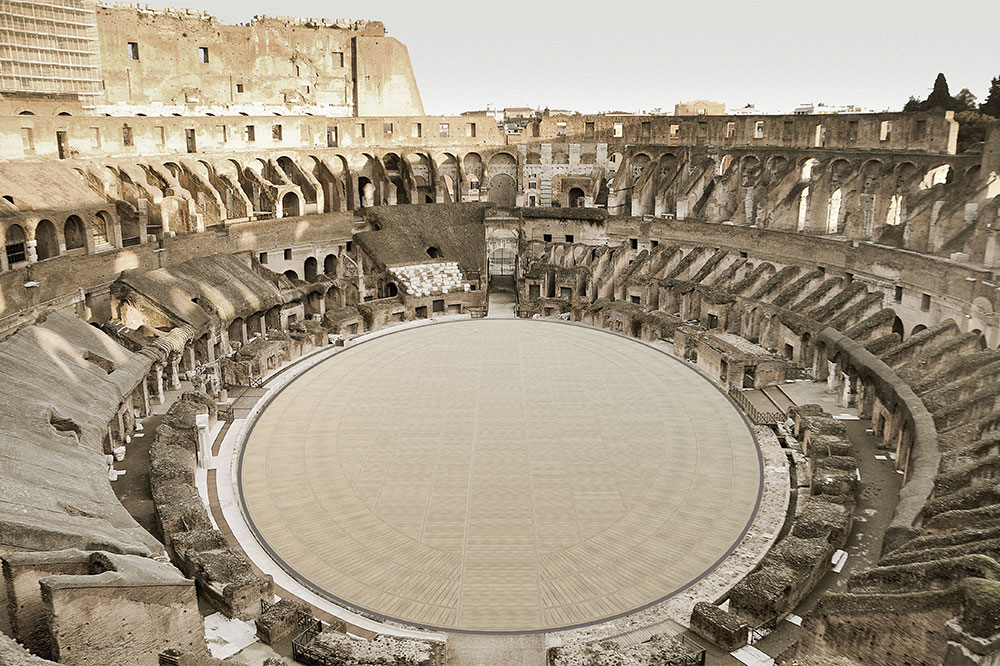At the end of last year the Italian ministry of culture announced that it was seeking proposals for an ambitious new project, with an €18.5m budget: the construction of a retractable wooden floor for the Colosseum. On 2 May the winning design, part of the ministry’s wider strategy of restoring and reorganising Rome’s archaeological sites, was unveiled to much fanfare – as well as criticism from some commentators, who have questioned the project’s price tag and whether the Colosseum needs a floor at all.
Of course, the building originally had a wooden floor, covered in sand (harena in Latin, whence our ‘arena’) to soak up the aftermath of the gladiatorial combats, executions, and beast hunts held there. This floor sat above a complex network of cells, passageways and mechanical hoists: the hypogeum, which is now almost entirely open to the sky. From here combatants, animals and scenery could be hoisted up through the floor and into the arena.
The Colosseum retained versions of this functional wooden floor throughout its life as a working arena, from its dedication in around 80 AD to its eventual abandonment in the declining Christian Rome of the sixth century, undergoing multiple renovations and refits throughout that time. The building then began to fall apart. It was looted as a quarry, and partially collapsed in an earthquake; sections of it were reused for (inter alia) a burial ground, a fortress, a chapel, a religious confraternity, housing, and workshops. During these vicissitudes the hypogeum filled up with detritus.
By the time the ruins began to be appreciated for their antiquity the oval arena had become an expanse of earth, tidied up by the popes who believed that the early Christians had been martyred there. Benedict XIV erected the Stations of the Cross around the perimeter in the mid 18th century, and his successors made various interventions in the 19th. By the time Byron visited and Ippolito Caffi painted it or, a little later, Henry James’ Daisy Miller trysted there by night, it had more or less the appearance of the old arena. But as the new discipline of archaeology developed, excavations began to probe the hypogeum; under Mussolini it was, like many of the ruins of imperial Rome, fully cleared out and ‘liberated’ from later incrustations. The view we see today, then, of the hypogeum laid bare, has only existed for the last five per cent or so of the building’s life.
Interior of the Colosseum (mid 1800s), Ippolito Caffi. National Gallery of Art, Washington, D.C.

The Milanese firm Ingegneria has won the €18.5m contract to install the modern floor above this void. The flexible and elegant engineering structure takes the form of 3,000 square metres of sustainable Accoya wood slats, whose layout expresses the shape of the linear and annular corridors of the hypogeum below. The slats will be adjustable, rotating and retracting to allow light and air into the substructures and to provide at least a partial view of them from above. The installation will be reversible, it is said, to avoid permanent damage to the remains.
Walking out on to this floor will be a significant change from the current visitor experience of the Colosseum, providing for the first time a gladiator’s-eye view from the centre of the arena up to the seating (cavea), and adding to the access to the upper and lower levels that has gradually increased in recent years. The arena floor is a popular viewpoint for users of my digital reconstruction of the building – and it will be good to experience it in real life, perhaps accompanied by the sort of augmented reality app that is becoming a staple at Roman sites, which here might help fill in the missing seats, combatants, and crowds. While the new floor will at least partly conceal the hypogeum from sight – and thus remove the current opportunity to understand its rather complex layout in plan view from above – it will also give any visitor who ventures down there at least an impression of the dark, confined space it must once have been.
What the proposed new floor does, then, is privilege something approximating the original experience of the building, both at arena and hypogeum level, over the lucid but artificial skeletal archaeological layout that has become familiar.
Interior of the Colosseum, c. 1870. Photo: ANSA/Fratelli Alinari Museum Collections, Florence

This news has received a mixed response. Amid enthusiasm for the design there are concerns about damage to the ruins, about obscuring the hypogeum, and perhaps about the increased potential for the commercialisation of a site which is already a mainstay of Rome’s archaeological tourism industry. The building attracts more than seven million tourists annually in non-pandemic times, and can become congested. The floor area would be able to accommodate large additional numbers, and will also be used for as yet unspecified ‘cultural events’. The Italian culture minister Dario Franceschini promises that these will be of the ‘highest quality’, but there is a long history of using ancient remains in Rome and elsewhere to house spectacles, not without risk to the integrity (some might say the dignity) of the ruins. The Baths of Caracalla housed opera performances, moved safely out of the main structure after 1993; in 2017 a short-lived rock opera about the life of Nero, held amid the ruins of the emperors’ palaces on the Palatine hill, attracted considerable controversy.
The price tag for the project has also come under criticism. The Colosseum is one of a number of archaeological sites in Rome recently restored, generously but not uncontroversially, by private philanthropy rather than state resources: the luxury shoe brand Tod’s came up with the €25 million cost of that project, which raises a potential concern about further commercial partnerships in future – to cover, for example, the cost of maintaining the high-tech floor. Commercial pressure and archaeological concerns may continue to be in tension in such a high-profile space.
The new floor is scheduled for completion in 2023. Covid permitting, the millions of visitors to the refloored Colosseum will then be able to give their own verdict: thumbs up, or thumbs down.



